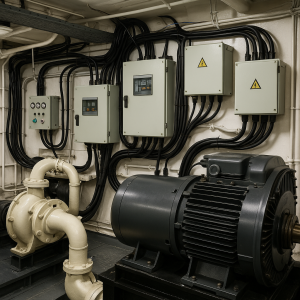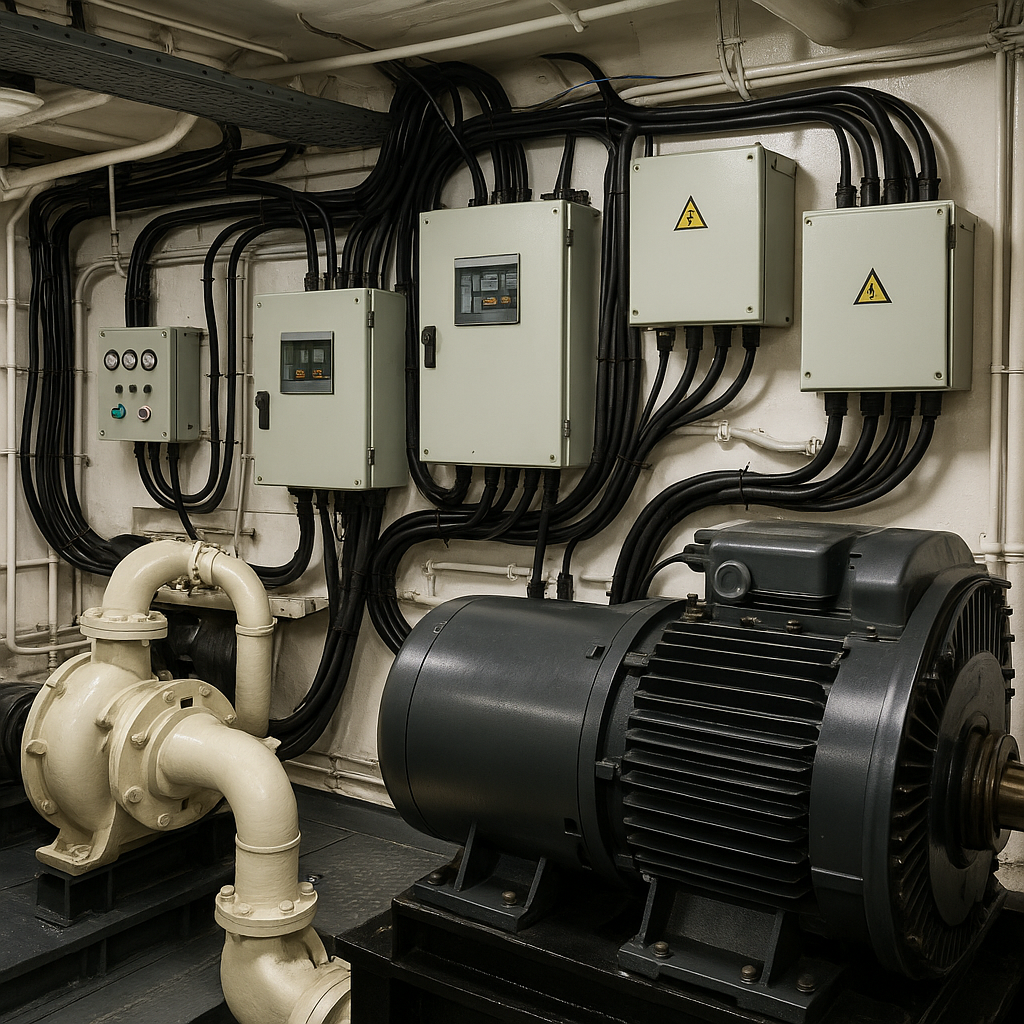Explore the core of marine electrical systems in this detailed guide. Learn how ships generate, distribute, and control power onboard with smart technologies and safety standards.
Modern vessels are floating cities. From container ships to cruise liners, they rely heavily on sophisticated electrical systems to operate safely and efficiently. These systems do far more than turn on the lights—they drive propulsion motors, control navigation, support communications, and ensure vital safety mechanisms function around the clock. Whether you’re a marine engineering student or an officer upgrading your skills, understanding marine electrical systems is fundamental.

Why Marine Electrical Systems Matter in Modern Maritime Operations
Electrical systems are the lifeblood of any vessel. A failure in power distribution or control systems could bring operations to a standstill or endanger the crew. According to the UK’s Marine Accident Investigation Branch (MAIB), electrical faults contributed to over 10% of reported marine incidents between 2018 and 2023. In an era of smart ships and digital integration, dependable electrical infrastructure is non-negotiable.
Moreover, with stricter environmental regulations like the IMO 2020 sulphur cap and upcoming decarbonisation goals under the IMO GHG strategy, there is growing demand for hybrid and electric propulsion systems. These new energy-efficient configurations require advanced marine electrical engineering to function safely under harsh conditions.
Key Components and How They Work Together
Marine electrical systems encompass several key parts:
Power Generation: Generators and Shore Power
Most ships use diesel-driven generators, often coupled with an alternator to produce alternating current (AC). Larger vessels have multiple generator sets (gensets) to maintain redundancy and optimise fuel consumption.
In port, many ships use shore power (cold ironing) to reduce emissions—a solution encouraged by the European Commission’s Green Ports Strategy and ESPO recommendations.
Power Distribution: Switchboards and Transformers
The power generated onboard must be distributed to various parts of the ship. Main switchboards and distribution panels direct electricity from the generator to major loads. Step-down transformers reduce voltage to safer levels for lighting and electronics.
Control and Monitoring: PLCs and Automation
Programmable Logic Controllers (PLCs) and Human-Machine Interfaces (HMIs) monitor parameters like voltage, current, and frequency. Many modern ships use integrated platform management systems (IPMS) for real-time diagnostics, load sharing, and alarm logging.
Class societies like DNV and Lloyd’s Register now require IPMS integration in advanced ship designs.
Emergency Power Systems
SOLAS regulations mandate backup power sources such as emergency diesel generators or batteries to support critical equipment (navigation lights, emergency pumps, fire detection) in the event of main power failure. These are tested regularly during port state control inspections (Paris MoU).
–
Advancements in Marine Electrical Engineering
Hybrid and All-Electric Propulsion
Battery energy storage systems (BESS), such as those supplied by Wärtsilä and Corvus Energy, are now standard in many ferries and offshore support vessels. Combined with diesel-electric or LNG-electric configurations, these systems cut emissions while enhancing efficiency.
The world’s first fully electric container ship, Yara Birkeland (Norway), launched in 2021, is a proof of concept for zero-emission shipping.
DC Grids and Variable Frequency Drives (VFDs)
Traditionally, AC systems dominated marine power. However, DC grids are now emerging due to their efficiency in integrating renewable energy sources and battery systems. Variable frequency drives (VFDs) allow motors and pumps to run at optimal speeds, reducing energy waste.
Smart Sensors and Predictive Maintenance
Internet of Things (IoT) devices now monitor insulation resistance, harmonic distortion, and breaker health. Predictive analytics can identify potential failures before they occur—saving both downtime and repair costs. According to Lloyd’s List Intelligence, smart ship electrical systems could reduce unplanned maintenance by 40%.
Cybersecurity in Electrical Systems
With increasing digitalisation, cyber threats to power management systems are a growing concern. The IMO’s Maritime Cyber Risk Management guidelines (MSC-FAL.1/Circ.3) stress that electrical systems must be designed with secure architecture to prevent hacking or malware breaches.
–
Real-World Application: Power Distribution in Cruise Ships
Take a modern cruise ship like Royal Caribbean’s Symphony of the Seas. It features six medium-speed diesel generators providing 100+ MW of electrical power—enough for a small town. This energy drives Azipod propulsion units, HVAC systems, freshwater production, navigation, lighting, elevators, kitchens, and entertainment.
Engineers rely on detailed mimic diagrams, automation dashboards, and fault diagnostics from the IPMS to manage this complex load. Emergency switchboards ensure that fire alarms, lifeboat winches, and steering systems remain online even if the main power fails.
–
Challenges in Marine Electrical Systems
Harsh Environments and Maintenance
Salt air, vibration, temperature changes, and limited space all affect reliability. According to a study in Marine Structures journal, corrosion and insulation breakdown are leading causes of electrical fires onboard ships.
Regular inspection, IR thermal imaging, megger testing, and condition-based maintenance are critical. The IACS Unified Requirement E10 sets out environmental testing standards for electrical equipment.
Human Error and Training Gaps
Incorrect switchboard operation or isolation of power can lead to arc flash injuries or system blackouts. STCW Code and IMO Model Course 7.08 require marine engineers to undergo hands-on training in electrical safety, yet gaps remain—especially in developing maritime nations.
–
Future Outlook: Towards Autonomous Energy Management
Digital Twin Integration
Using digital twins of electrical systems enables operators to simulate faults, predict energy load trends, and test modifications without risk. Companies like ABB and Kongsberg are pioneering this technology on ferries and tankers.
Integration with Renewable Energy and Hydrogen
With stricter IMO decarbonisation timelines, future ships may integrate wind-assist systems or hydrogen fuel cells. Marine electrical architectures will have to adapt for safe, dual-fuel, or renewable integration—posing new challenges for engineers and regulators alike.
Modular Power Systems
Next-gen ship designs may feature containerised power units, allowing for modular upgrades or fast repairs. This idea is being explored by RISE of Sweden and EU TEN-T innovation clusters.
–
Frequently Asked Questions (FAQ)
What voltage do ships typically use?
Large vessels operate at 440V or 690V AC for machinery, while lighting and electronics use 220V or 110V AC. DC systems (24V, 48V) are used for control and automation.
What is shore power and why is it used?
Shore power (cold ironing) allows ships to turn off onboard generators while docked, reducing fuel consumption and air pollution. Ports in California, Norway, and the EU now mandate its use for certain vessel types.
What safety standards apply to marine electrical systems?
SOLAS, IEC 60092, IACS UR E10, and Classification Society rules (like DNV or BV) regulate design, testing, and maintenance. Port State Control checks often review electrical logbooks and safety drills.
Are electric ships a reality or just a concept?
Electric ships already exist—mainly in short-sea routes or ferries. Long-haul electric shipping is still in testing, but hybrid vessels are increasingly common.
What are the key risks in marine electrical systems?
Key risks include fire from overloads, insulation failure, arc flash incidents, and power loss due to generator faults or human error.
Can solar or wind power supply ship electricity?
Solar panels can supply auxiliary loads, especially on yachts or coastal vessels. Wind-assist systems (rotor sails) reduce engine load but aren’t direct power sources.
Conclusion
Marine electrical systems are the invisible network powering every operation onboard—from starting the engines to navigating across oceans safely. As regulations, technologies, and fuel sources evolve, so too must the electrical systems that support them. Engineers of the future will need not just technical knowledge, but digital fluency, regulatory awareness, and sustainability insight.
Whether you’re preparing for your first sea voyage or overseeing the design of a next-gen ship, understanding how these systems work is no longer optional—it’s essential.
References
- International Maritime Organization. (2023). IMO Guidelines on Cyber Risk Management. IMO.org
- Lloyd’s Register. (2024). Marine Electrical Systems Approval Guidance.
- DNV. (2024). Class Rules for Integrated Automation and Power Systems. dnv.com
- Wärtsilä. (2023). Marine Electrification Brochure.
- MAIB Reports (2018–2023). gov.uk
- IACS. (2023). Unified Requirements: Electrical Equipment.
- Journal of Marine Science and Engineering. (2023). Recent Trends in Shipboard Power Systems.
- STCW Convention and IMO Model Course 7.08.
- Corvus Energy. (2023). Case Studies in Hybrid Marine Propulsion.
- Royal Institution of Naval Architects. (2023). RINA Papers on Electrical Integration in Smart Ships.

